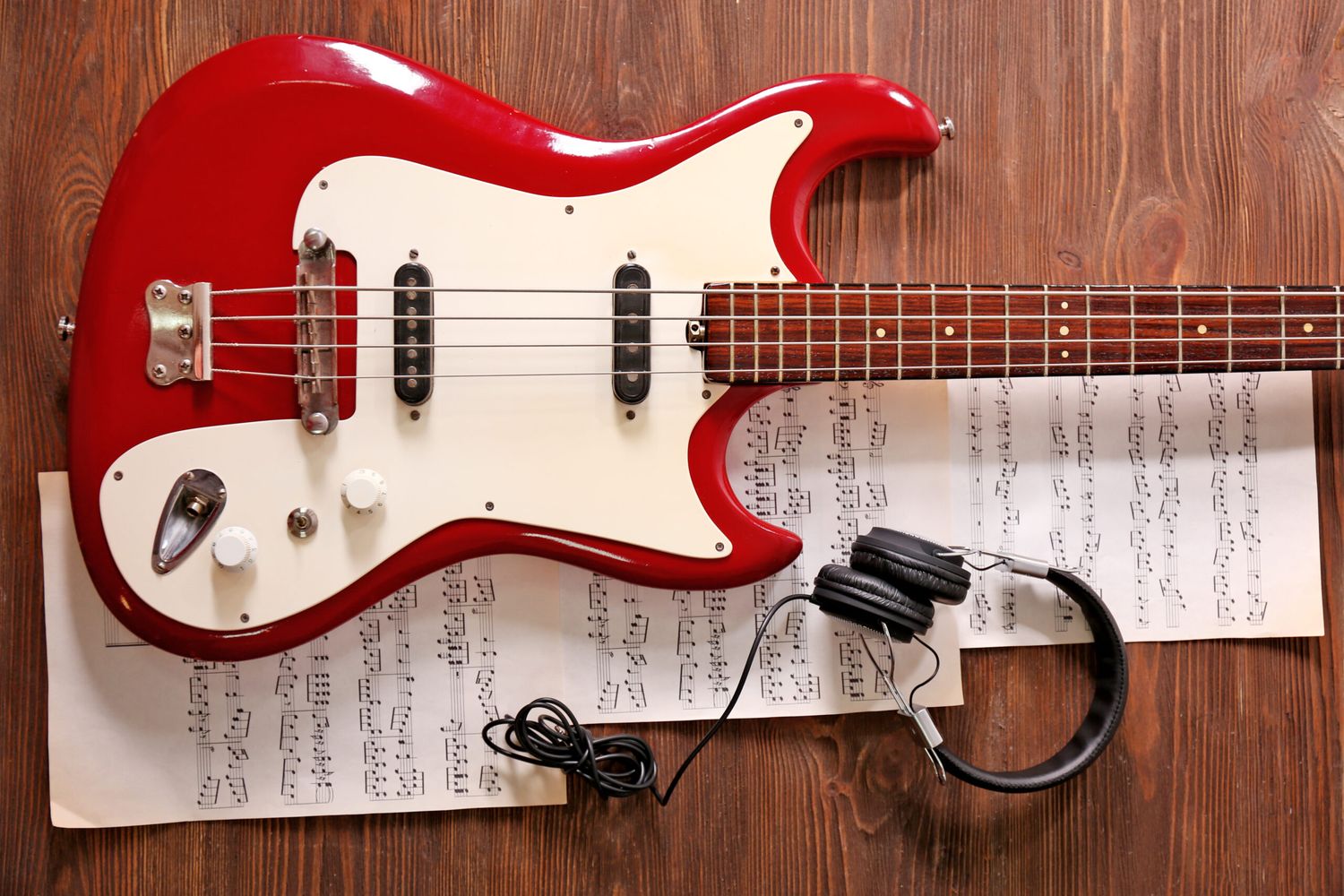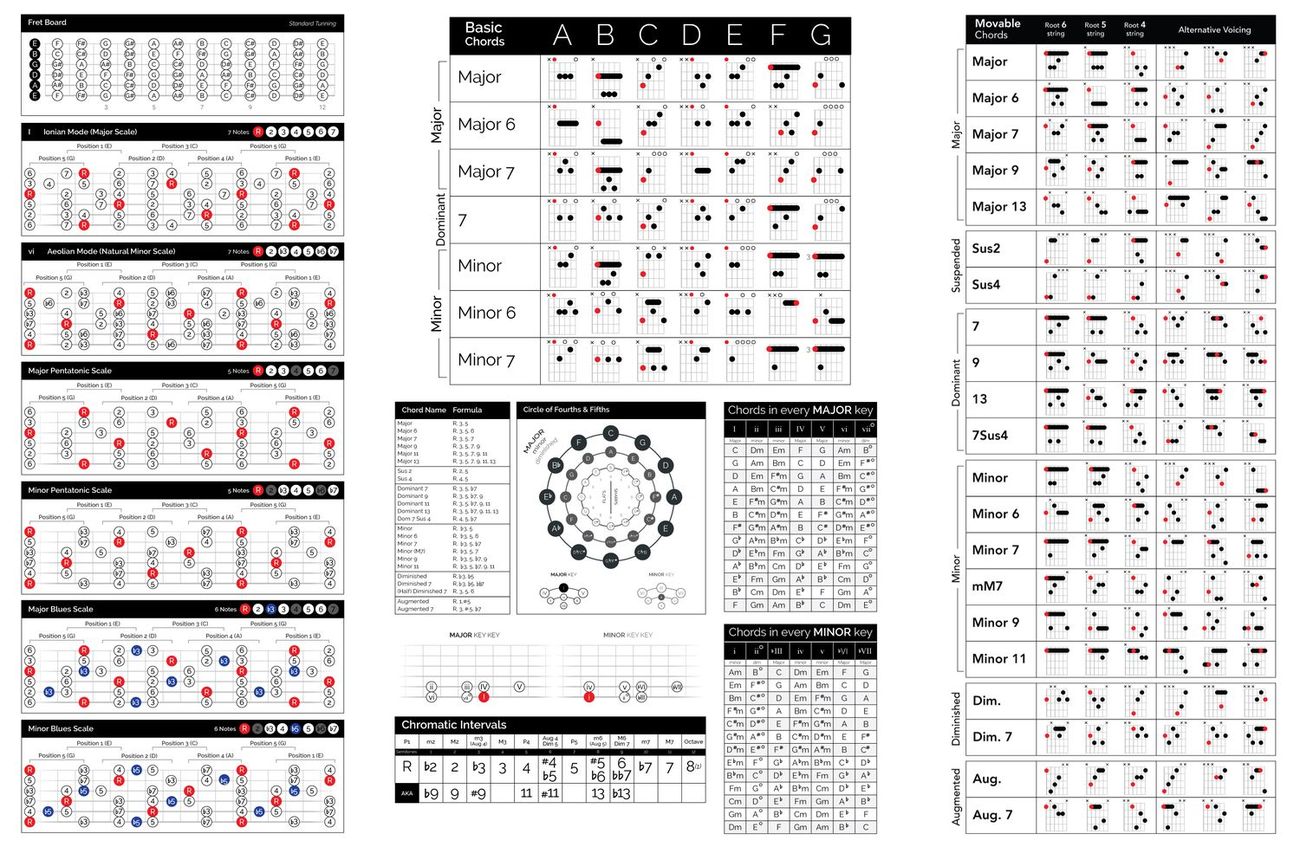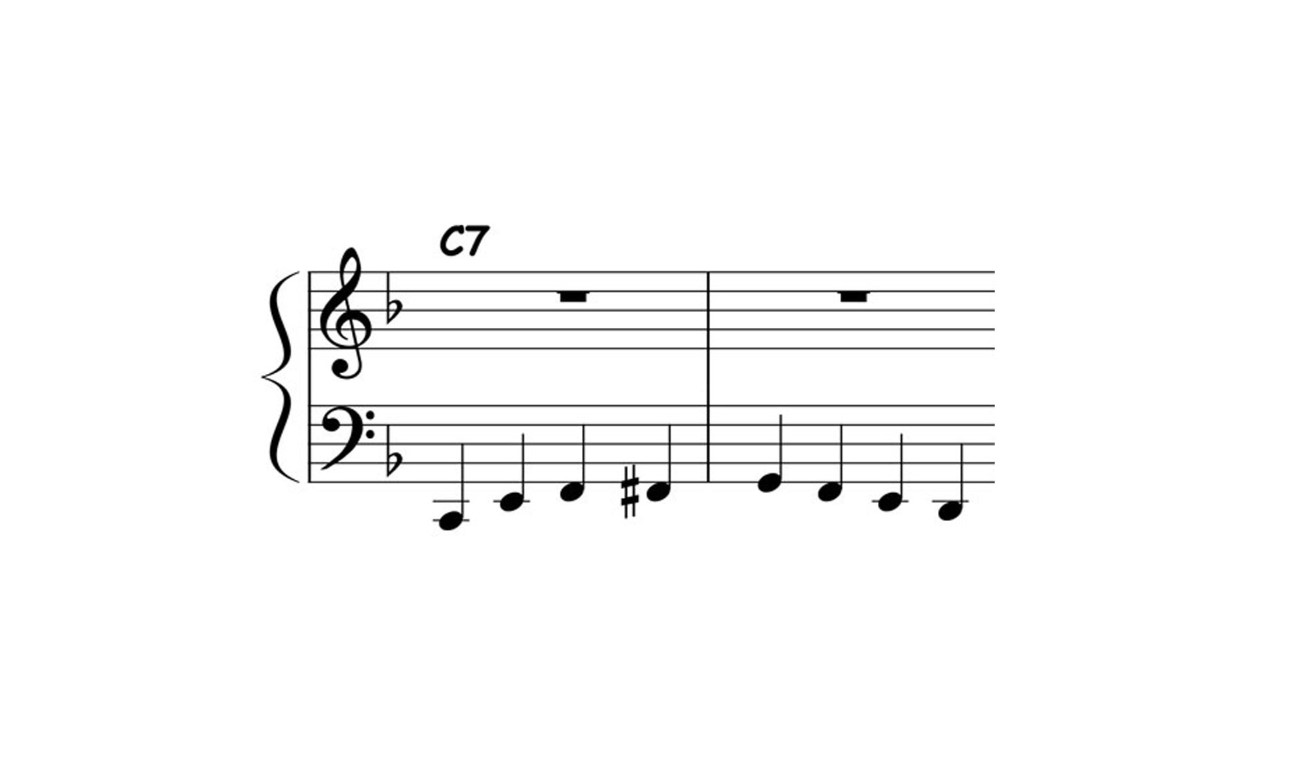Home>Production & Technology>Music Theory>How To Learn Bass Music Theory


Music Theory
How To Learn Bass Music Theory
Modified: February 14, 2024
Learn the essentials of music theory for bass players and level up your playing skills. Dive into chord progressions, scales, and more in this comprehensive guide.
(Many of the links in this article redirect to a specific reviewed product. Your purchase of these products through affiliate links helps to generate commission for AudioLover.com, at no extra cost. Learn more)
Table of Contents
Introduction
Welcome to the world of bass music theory! If you’re an aspiring bassist or even a seasoned player, understanding the fundamentals of music theory can greatly enhance your skills and overall musicianship. Music theory provides a framework for understanding how music works, allowing you to analyze, interpret, and create your own basslines with confidence.
Whether you’re playing in a band, jamming with friends, or composing your own music, having a solid foundation in music theory can take your bass playing to the next level. It can help you make informed decisions about what notes to play, which chords to choose, and how to create harmonies and melodies that complement the song.
In this article, we will explore the basics of music theory as it relates to bass playing. We’ll cover topics such as notes and scales, chords and progressions, harmony and melody, rhythm and timing, and how to apply these concepts to your bass playing. So grab your bass guitar, get ready to dive into the wonderful world of music theory, and unlock a whole new level of musical expression!
Basics of Music Theory
Before diving into bass music theory, let’s start with the fundamentals. Music theory is the study of the structure, elements, and systems of music. It provides a set of rules and principles that help us understand and communicate the language of music. By learning music theory, you’ll gain a deeper understanding of how and why certain musical elements work together, enabling you to make informed musical choices.
The basic building blocks of music theory include notes, scales, chords, harmony, melody, rhythm, and form. Each of these elements plays a crucial role in creating music that is pleasing to the ear and emotionally engaging. Understanding these elements will give you the tools to analyze, interpret, and create your own basslines effectively.
Notes are the fundamental units of music. They are represented by letters from A to G and can be played on various instruments, including the bass guitar. Notes have different pitches, which determine whether they sound high or low. By combining different notes, you can create melodies and basslines.
Scales are a sequence of notes arranged in ascending or descending order. They provide the foundation for melody and harmony in music. The most common scale in Western music is the major scale, which consists of seven notes. Other scales, such as the minor scale or the pentatonic scale, add different flavors and emotions to your bass playing.
Chords are made up of three or more notes played simultaneously. They create harmony and provide a strong foundation for the bassline. Understanding chord progressions is essential for bass players, as it allows you to create interesting and supporting basslines that complement the other instruments in the band.
Harmony is the combination of different notes and chords that creates the tonal structure of a piece of music. It provides a sense of stability and tension, and understanding how to create harmonies will help you play more melodically on the bass.
Melody is the sequence of single notes played one after the other. It is the part of the music that is most recognizable and memorable. As a bassist, you’ll often be playing the root notes of chords, which provide the foundation for the melody of the song.
Rhythm is the time aspect of music. It determines the duration of notes and the arrangement of beats. Developing a strong sense of rhythm is essential for a bass player, as you’ll be responsible for setting the groove and driving the song forward.
Form refers to the structure and organization of a piece of music. It determines how different sections of a song are arranged and repeated, such as verses, choruses, and bridges. Understanding form will help you navigate through a song and know when and where to play certain basslines.
By grasping the basics of music theory, you’ll be equipped with the knowledge and skills to create basslines that not only support the song but also add depth and musicality. So let’s move on to the next section and explore the unique characteristics of the bass guitar in relation to music theory.
Understanding the Bass Guitar
The bass guitar is a unique instrument that plays a crucial role in the rhythm section of a band. Its primary function is to provide the foundation, groove, and support for the other instruments in the ensemble. As a bassist, it’s important to understand the specific characteristics and role of the bass guitar within the context of music theory.
One of the key features of the bass guitar is its low register. It is specifically designed to produce low-pitched notes, typically an octave below the guitar or other melodic instruments. This low register gives the bass guitar its distinct deep and powerful sound, providing a solid foundation for the harmony and rhythm of a song.
Another important aspect of the bass guitar is its function as a rhythm instrument. While the other instruments may focus more on melody and harmony, the bass guitar’s primary role is to establish and maintain the beat and groove of the song. By playing in sync with the drummer, the bassist creates a tight and cohesive rhythm section that drives the music forward.
In terms of music theory, the bass guitar most commonly plays the root notes of chords. The root note is the foundation of a chord and provides the tonal center of a musical passage. By playing the root notes, the bass guitarist helps to establish and reinforce the harmonic structure of a song.
However, playing root notes is not the only role of the bass guitar. Bassists also have the freedom to explore melodic and rhythmic variations within the context of a song. This can involve playing passing tones, creating melodic fills, or adding syncopated rhythms to enhance the overall musicality of the bassline.
Understanding the function of the bass guitar in relation to music theory allows you to make informed decisions when creating basslines. By focusing on the root notes of chords and playing in sync with the rhythm section, you can create a solid foundation for the other instruments to build upon.
Additionally, being aware of the various scales and modes allows you to add melodic elements to your playing. By incorporating scale patterns, arpeggios, and chromatic passing tones, you can create interesting and dynamic basslines that add depth and musicality to the song.
Overall, understanding the unique characteristics and role of the bass guitar within the context of music theory is essential for any bassist. It not only enables you to fulfill your role as the foundation of the rhythm section but also gives you the tools to create compelling and expressive basslines that enhance the overall musical experience.
Notes and Scales
When it comes to understanding music theory on the bass guitar, notes and scales are fundamental concepts to grasp. Notes are the individual building blocks of music, while scales are patterns of notes that provide the framework for melodies and basslines.
On the bass guitar, each string represents a specific pitch, allowing you to play notes across the instrument’s range. The standard tuning for a 4-string bass guitar is E, A, D, and G, with the lowest-pitched string being the thickest one, tuned to E. By pressing down on the strings at different frets, you can change the pitch and play different notes.
Notes are typically named using the letters A through G. After G, the sequence starts over at A and repeats. Each note can have variations known as accidentals, which are represented by symbols like sharp (♯) and flat (♭). Accidentals raise or lower the pitch of a note by a half-step.
Scales, on the other hand, are patterns of notes arranged in ascending or descending order. They provide the foundation for melodies and basslines, helping to create a sense of tonality in a piece of music.
One of the most common scales to learn on the bass guitar is the major scale. The major scale follows a specific pattern of whole steps (W) and half steps (H): W-W-H-W-W-W-H. For example, if you start on the root note of C, the C major scale would be C-D-E-F-G-A-B-C.
The major scale is the basis for understanding harmony and chord progressions in music theory. Chords are built from the notes of a scale, and knowing the major scale will allow you to identify the corresponding chords and their relationships within a key.
Other common scales used in bass playing include the minor scale, pentatonic scale, and blues scale. The minor scale has a different pattern of steps than the major scale and creates a darker and more melancholic mood. The pentatonic scale is a five-note scale that is widely used in various genres and provides a bluesy sound. The blues scale adds an additional note to the pentatonic scale, giving it a distinct blues flavor.
By familiarizing yourself with different scales and understanding their patterns and applications, you’ll be able to create basslines that complement the chords and melodies of a song. Experiment with playing scales in different positions and patterns on the bass guitar to develop your technique and musicality.
Additionally, understanding scales will help you improvise and create basslines on the fly. By combining scale patterns, adding passing tones, and exploring rhythmic variations within a scale, you can create interesting and dynamic basslines that enhance the overall musical experience.
By developing a solid foundation in notes and scales on the bass guitar, you’ll gain the tools and knowledge to navigate the instrument with confidence. It will open up a world of possibilities and creativity, allowing you to create basslines that are not only technically proficient but also musically engaging and expressive.
Chords and Progressions
Chords and progressions are essential components of music theory, and understanding them is crucial for any bassist. Chords are a collection of three or more notes played simultaneously, while progressions refer to the sequence of chords in a song.
One of the primary roles of the bass guitar is to provide a strong foundation for the harmony of a song by playing the root notes of chords. The root note is the main note that defines a chord and provides stability and tonality. By playing the root notes in a rhythmic and consistent manner, the bass guitar helps establish the harmonic structure and drive the song forward.
Many songs are built around chord progressions, which are specific sequences of chords that create the overall mood and structure of a piece. Common chord progressions include the I-IV-V progression, which is widely used in various genres, and the ii-V-I progression, commonly found in jazz music.
The I-IV-V progression, for example, is prevalent in blues, rock, and pop music. In the key of C, it consists of C, F, and G chords. As a bassist, you can create a solid bassline by emphasizing the root notes of each chord and playing rhythmic patterns that enhance the groove of the song.
Understanding chord progressions allows you to anticipate and anticipate chord changes while playing the bass. This skill is essential for creating smooth transitions between chords and providing a cohesive and seamless musical experience. By listening to the other instruments and the overall rhythm of the song, you can choose appropriate notes and rhythms that harmonize with the chords being played.
When it comes to bass guitar, chord inversions and arpeggios are also valuable tools. Chord inversions involve playing the notes of a chord in a different order, often placing a different note in the bass. This technique can add variety and movement to your basslines and help create more melodic and interesting parts.
Arpeggios are when you play the individual notes of a chord successively rather than simultaneously. It allows you to create more intricate and intricate basslines that highlight the individual notes of a chord. Arpeggios can be used to add melodic and rhythmic interest to your bass playing, giving you more versatility and expressiveness.
By understanding chords and progressions, you’ll be able to create basslines that not only support the other instruments but also add depth, movement, and musicality to a song. Experiment with different chord progressions, inversions, and arpeggios to enhance your bass playing and develop a unique style.
Lastly, an important aspect of playing bass guitar in relation to chords and progressions is the ability to play with dynamics and feel. Pay attention to the dynamics of the song and the mood it conveys. Use techniques like muting, sliding, and varying your attack to add texture and dynamics to your basslines. Remember, playing the right notes is important, but how you play them can greatly impact the overall musicality of your bass playing.
By mastering chords and progressions on the bass guitar, you’ll be equipped with the skills to create basslines that support and enhance the harmony of a song. Experiment, practice, and listen to different genres and styles to expand your musical vocabulary and develop your own unique bass style.
Harmony and Melody
Harmony and melody are two essential components of music theory that work together to create a holistic and captivating musical experience. Understanding how harmony and melody interact is key for any bassist looking to elevate their playing and contribute creatively to a song.
Harmony refers to the combination of different notes and chords that create the tonal structure of a piece of music. It provides a sense of stability, tension, and resolution. When playing bass, you have the responsibility of anchoring the harmony by playing the root notes of the chords being played by other instruments.
By emphasizing the root notes, you help establish a solid foundation and reinforce the chord progression of the song. This allows the other musicians to build upon your bassline and contribute their own harmonic and melodic ideas, creating a rich and cohesive musical arrangement.
However, as a bassist, you also have the opportunity to add melodic elements to your playing while still maintaining the harmonic structure. This can be done through techniques such as playing passing tones, creating melodic fills, or incorporating scale patterns within the context of the given chords.
The melody, on the other hand, is the sequence of single notes played one after the other. It is the part of the music that is most recognizable and memorable to the listener. While the melody is often carried by other instruments or vocals, as a bassist, you can contribute to the melodic aspect by playing melodic fills or variations within the framework of the song.
When playing melodic basslines, it’s important to be mindful of the overall harmony and melody of the song. Listen to the other instruments and vocals and find ways to complement and enhance the melodic phrases being played or sung. This can be achieved by using scales, arpeggios, or melodic patterns that fit within the chords and overall key of the song.
Developing an understanding of harmony and melody on the bass guitar will give you the ability to create basslines that not only provide a solid foundation but also contribute melodically to the music. By expressing yourself melodically while staying aware of the harmony, you’ll be able to create basslines that are musically engaging, memorable, and add depth to the overall musical arrangement.
It’s worth noting that the relationship between harmony and melody is subjective and depends on the style of music being played. In some genres, the bass may have a more prominent melodic role, while in others, it may primarily serve the harmonic function. Understanding the style and context of the music you’re playing will help you navigate the balance between harmonic and melodic elements in your basslines.
Remember, as a bassist, your role is to serve the song and support the overall musical vision. Embrace the nuances of harmony and melody and explore ways to contribute creatively while working harmoniously with the other musicians in the band. By doing so, you’ll be able to play basslines that not only enhance the music but also showcase your musicality and ability to add depth and emotion through your instrument.
Rhythm and Timing
Rhythm and timing are vital aspects of music theory that greatly influence the overall feel and groove of a song. As a bassist, it is your responsibility to provide a solid rhythmic foundation and contribute to the overall rhythmic drive of the music.
Rhythm refers to the aspect of music that deals with the arrangement, duration, and emphasis of sounds over time. It is the backbone of any musical composition, setting the pace and energy of the song. When playing the bass guitar, you have the unique opportunity to shape the rhythm and drive the momentum of the music.
One of the key elements to focus on as a bassist is maintaining a steady and consistent sense of time. This means having a strong internal pulse and playing in perfect sync with the drummer and other rhythm instruments. By understanding and internalizing rhythmic patterns, you can lay down a solid groove and ensure that everyone in the band is in sync.
Furthermore, playing with a good sense of timing is crucial. This involves playing notes and rhythms accurately and precisely, to maintain the desired groove of the song. Developing a keen sense of timing will allow you to lock in with the drummer and create a tight and cohesive rhythm section.
Playing with good timing also opens up possibilities for rhythmic variations and syncopations. Syncopation refers to the accenting or emphasizing of off-beat notes or beats, creating an interesting and unexpected rhythmic pattern. Experimenting with syncopated rhythms adds depth and complexity to your basslines, making them more engaging and dynamic.
In addition to rhythm and timing, understanding different rhythmic styles and patterns is essential. Different genres have their own distinct rhythmic elements, such as swing in jazz or reggae’s specific off-beat feel. By studying and immersing yourself in different styles, you can expand your rhythmic vocabulary and enhance your versatility as a bassist.
Developing your sense of rhythm and timing can be achieved through regular practice and playing with a metronome or drum tracks. Be attentive to different rhythms and rhythmic subdivisions such as quarter notes, eighth notes, and sixteenth notes. Internalize these rhythms and experiment with different patterns and combinations to build your rhythmic dexterity.
Communication within the rhythm section is also crucial for achieving a tight and cohesive sound. Listening and responding to the drummer’s accents and fills, coordinating with the guitar or keyboard player, and being aware of the overall dynamics of the song will help you enhance the rhythmic feel and contribute to a solid musical performance.
Ultimately, rhythm and timing are integral components of music theory that allow you to create a strong foundation, drive the song forward, and add musicality to your bass playing. By refining your sense of rhythm, timing, and understanding different rhythmic patterns, you can become an exceptional bassist who anchors the band, keeps the groove alive, and captivates the audience with infectious rhythms.
Applying Music Theory to Bass Playing
Applying music theory to your bass playing can greatly enhance your musicality and creativity. By understanding the principles behind chords, scales, and harmony, you can make informed choices while creating basslines and contribute meaningfully to the overall musical arrangement.
When applying music theory to bass playing, it’s important to remember that theory is a tool, not a set of rigid rules. It provides a framework for understanding how music works, but it should also be used as a guide to fuel your own musical intuition and expression.
One way to apply music theory to your bass playing is through chord and scale relationships. By knowing the intervals within a scale and the corresponding chords in a key, you can create basslines that harmonize well with the rest of the music. For example, when a chord progression moves to a new chord, you can target the relevant chord tones on the bass to create a strong and cohesive sound.
You can also explore different chord inversions and arpeggios to add depth and variation to your basslines. Experimenting with different voicings and playing chord tones in different octaves can create interesting melodic and harmonic textures.
Understanding music theory also enables you to add melodic elements to your bass playing. By incorporating scale patterns, passing tones, and melodic fills, you can create basslines that are not only rhythmically solid but also melodically engaging.
Another aspect to consider is the concept of tension and release. Music theory allows you to understand how to build tension through dissonance and resolve it through consonance. By employing techniques such as chromaticism or playing non-chord tones, you can create tension in your basslines that resolves harmonically, adding excitement and interest to your playing.
Moreover, music theory gives you the tools to analyze and transcribe songs accurately. By honing your ear training skills and transcribing basslines, you can understand how theory is applied in practice and gain insights into different musical styles and techniques. This can be a valuable learning experience and a source of inspiration for your own bass playing.
Remember that applying music theory to your bass playing is an ongoing process. Continuously exploring and experimenting with different concepts and techniques will expand your musical palette and allow you to develop your own unique style. It’s about finding the sweet spot between theory and creativity, using theory as a foundation and allowing your own musical intuition to guide your playing.
Lastly, don’t forget that playing with feeling and musicality is equally important. While theory provides a framework, it’s your expression and interpretation that bring the music to life. Use theory as a tool to support your creative vision, and let the music flow from your heart and soul.
By applying music theory to your bass playing, you’ll become a more versatile and confident bassist. You’ll have a stronger foundation for creating basslines, a deeper understanding of harmony and melody, and the ability to contribute to the overall musical experience in a meaningful and engaging way.
Ear Training and Transcribing
Ear training and transcribing are essential skills for any musician, and they play a vital role in developing your musicality and understanding of music theory as a bassist. These skills empower you to accurately identify and reproduce musical elements, enabling you to learn songs, analyze compositions, and improvise more effectively.
Ear training involves honing your ability to recognize and identify musical elements such as intervals, chords, melodies, and rhythms by ear. This skill allows you to play by ear, meaning you can learn songs or basslines simply by listening and figuring out the notes and rhythms without relying on sheet music or tabs.
Transcribing, on the other hand, is the process of notating or writing down a piece of music that you hear. It involves carefully listening to a song or bassline, identifying the notes, rhythms, and other musical nuances, and translating them into written notation or tablature. Transcribing helps deepen your understanding of music theory concepts, as it requires you to analyze and interpret the music you’re transcribing.
Ear training and transcribing go hand in hand, as developing your ear allows you to transcribe accurately, and transcribing, in turn, improves your ear-training skills. These skills work together to enhance your overall musicianship and bass playing abilities.
Ear training and transcribing allow you to analyze and understand the musical nuances in a song or bassline. You’ll become more familiar with different musical elements such as chord progressions, melodic patterns, rhythmic variations, and stylistic characteristics. This knowledge can be applied to your own bass playing, allowing you to incorporate similar techniques, create variations, or develop your own unique style.
Ear training also improves your ability to play with other musicians. By developing a keen ear, you’ll be able to listen and respond to what other musicians are playing, adapt to their phrasing and dynamics, and collaborate more effectively as a cohesive unit. This skill is especially valuable when jamming, improvising, or playing in a band.
Practicing ear training and transcribing can be done through a variety of techniques. Start by listening to different styles and genres of music, focusing on identifying individual notes, chord progressions, and rhythmic patterns. Singing or vocalizing the melodies or basslines you hear can also help develop your ear and internalize musical elements.
When transcribing, begin with simpler pieces or basslines and gradually work your way up to more complex songs. Use software or apps that allow you to slow down the music without affecting the pitch, making it easier to identify the notes and rhythms. Write down your transcriptions or use tablature to document your findings and refer back to them for practice and reference.
Remember that ear training and transcribing are skills that take time and consistent practice to develop. Start with short and manageable sections of songs and gradually increase the difficulty as you become more confident. It’s a lifelong journey of sharpening your musical ears and deepening your understanding of music theory.
By investing time in ear training and transcribing, you’ll become a more versatile and expressive bassist. Your ability to learn songs, understand musical concepts, and play with other musicians will greatly improve. These skills will enhance your overall musicianship and allow you to communicate and express yourself more effectively through your bass playing.
Tips for Practicing Bass Music Theory
Practicing bass music theory is crucial for developing your skills as a bassist and unlocking your full potential as a musician. Here are some tips to help you make the most of your practice sessions and effectively incorporate music theory into your bass playing:
- Start with the basics: Build a strong foundation by familiarizing yourself with the fundamentals of music theory. Learn the notes on the bass guitar, understand scales and chords, and grasp the basic concepts of harmony and rhythm.
- Break it down into manageable chunks: Rather than overwhelming yourself with too much information, focus on one concept or technique at a time. Master each concept before moving on to the next.
- Practice regularly: Consistency is key when learning and applying music theory. Set aside regular practice time, even if it’s just a few minutes each day, rather than cramming in long sessions sporadically.
- Apply theory to real-life situations: Take the theory you learn and apply it to real music. Play along with songs, jam with other musicians, or compose your own basslines. Putting theory into practice will help solidify your understanding and make it more applicable to your bass playing.
- Explore different genres and styles: Don’t limit yourself to one genre of music. Explore a variety of genres and styles to diversify your musical vocabulary. Each genre can teach you unique bass techniques and expand your understanding of music theory.
- Play with other musicians: Collaborating with other musicians provides valuable opportunities to apply music theory in a practical setting. It helps develop your listening skills, rhythm, and ability to communicate effectively within a band or ensemble.
- Record and analyze your playing: Use recording software or devices to capture your bass playing. Listen back to your recordings and analyze your performance. Look for areas where you can improve your timing, technique, and application of music theory concepts.
- Seek guidance from a teacher or mentor: Working with a bass instructor or music theory mentor can greatly accelerate your learning and provide valuable insights. They can guide you through the intricacies of music theory, offer personalized feedback, and help you overcome challenges.
- Be patient and persistent: Learning music theory and applying it to your bass playing takes time and patience. Don’t get discouraged by setbacks or slow progress. Keep practicing, stay motivated, and celebrate each small achievement along the way.
Remember, the goal of practicing bass music theory is not to become a theory expert but to harness its power to become a better and more versatile bassist. Embrace the journey and have fun exploring the endless possibilities that music theory can offer. With consistent practice and a curious mindset, you’ll continually grow as a bassist and musician.
Conclusion
Congratulations! You’ve now gained a deeper understanding of how to apply music theory to your bass playing. By incorporating the fundamentals of music theory, such as notes, scales, chords, harmony, melody, rhythm, and timing, you can elevate your bass playing to new heights, enhancing your musicality and creativity.
Remember that music theory is not meant to restrict your creativity but to serve as a guide and tool to unlock your full potential as a bassist. By internalizing the knowledge and concepts of music theory, you’ll have a solid foundation from which to explore and experiment, allowing you to create basslines that are musically engaging, supportive, and expressive.
As you delve deeper into music theory, be sure to practice regularly, applying what you’ve learned to real-life musical situations. Collaborate with other musicians, play along with songs, and transcribe basslines to further develop your ear and understanding of theory in a practical context.
Additionally, don’t forget the importance of rhythm and timing in your bass playing. Develop a strong sense of rhythm, experiment with syncopation and variations, and strive for a cohesive and tight performance with the drummer and rhythm section.
Lastly, always approach your practice sessions with patience, persistence, and a growth mindset. Learning and applying music theory to your bass playing is an ongoing journey, so celebrate every small achievement and embrace challenges as opportunities for growth.
By weaving music theory into your bass playing, you’ll become a versatile bassist who can confidently navigate chord progressions, create interesting basslines, and communicate harmoniously with other musicians. Whether you’re playing in a band, jamming with friends, or composing your own music, music theory will be your trusted ally, helping you express your musical ideas with depth and precision.
So go ahead, pick up your bass guitar, and let the knowledge and application of music theory inspire you to explore new horizons and become the bassist you’ve always envisioned. Happy playing!











